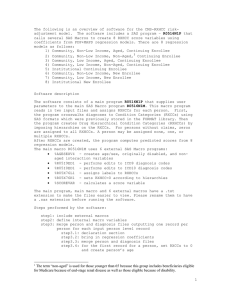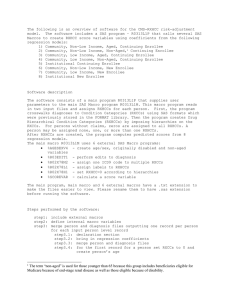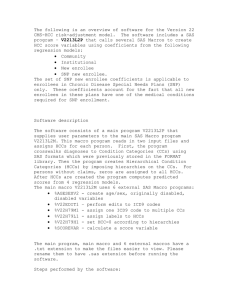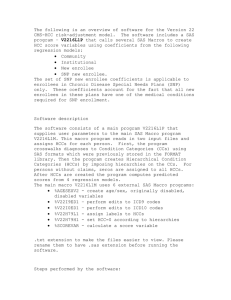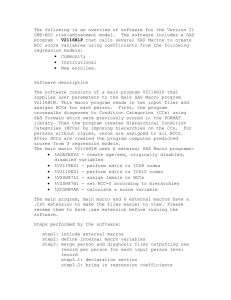The following is an overview of software for the CMS-RXHCC... calls several SAS Macros to create RXHCC score variables using
advertisement
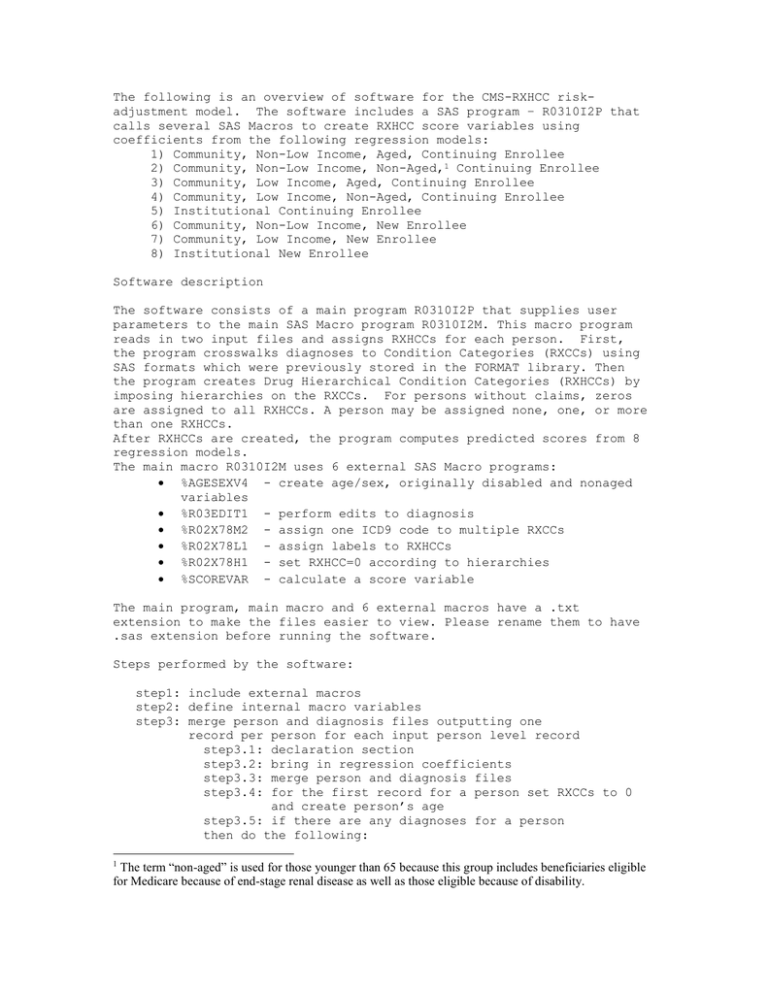
The following is an overview of software for the CMS-RXHCC riskadjustment model. The software includes a SAS program – R0310I2P that calls several SAS Macros to create RXHCC score variables using coefficients from the following regression models: 1) Community, Non-Low Income, Aged, Continuing Enrollee 2) Community, Non-Low Income, Non-Aged,1 Continuing Enrollee 3) Community, Low Income, Aged, Continuing Enrollee 4) Community, Low Income, Non-Aged, Continuing Enrollee 5) Institutional Continuing Enrollee 6) Community, Non-Low Income, New Enrollee 7) Community, Low Income, New Enrollee 8) Institutional New Enrollee Software description The software consists of a main program R0310I2P that supplies user parameters to the main SAS Macro program R0310I2M. This macro program reads in two input files and assigns RXHCCs for each person. First, the program crosswalks diagnoses to Condition Categories (RXCCs) using SAS formats which were previously stored in the FORMAT library. Then the program creates Drug Hierarchical Condition Categories (RXHCCs) by imposing hierarchies on the RXCCs. For persons without claims, zeros are assigned to all RXHCCs. A person may be assigned none, one, or more than one RXHCCs. After RXHCCs are created, the program computes predicted scores from 8 regression models. The main macro R0310I2M uses 6 external SAS Macro programs: %AGESEXV4 - create age/sex, originally disabled and nonaged variables %R03EDIT1 - perform edits to diagnosis %R02X78M2 - assign one ICD9 code to multiple RXCCs %R02X78L1 - assign labels to RXHCCs %R02X78H1 - set RXHCC=0 according to hierarchies %SCOREVAR - calculate a score variable The main program, main macro and 6 external macros have a .txt extension to make the files easier to view. Please rename them to have .sas extension before running the software. Steps performed by the software: step1: include external macros step2: define internal macro variables step3: merge person and diagnosis files outputting one record per person for each input person level record step3.1: declaration section step3.2: bring in regression coefficients step3.3: merge person and diagnosis files step3.4: for the first record for a person set RXCCs to 0 and create person’s age step3.5: if there are any diagnoses for a person then do the following: The term “non-aged” is used for those younger than 65 because this group includes beneficiaries eligible for Medicare because of end-stage renal disease as well as those eligible because of disability. 1 - create RXCCs using format specified in FMNAME (please see the Files supplied by the software section below for details on format library and formats specific to this version of software) - perform ICD9 edits if wanted using macro R03EDIT1 - create additional RXCCs using R02X78M2 macro step3.6: for the last record for a person do the following: - create demographic variables needed for score calculation (macro AGESEXV4) - create RXHCC using hierarchies (macro R02X78H1) - create RXHCC by NonAged interaction variables - set RXHCCs and interaction vars to zero if there are no diagnoses for a person - create scores for 5 continuing enrollee models - create scores for 3 new enrollee models step4: data checks and proc contents PART 1. Files supplied by the software. The following SAS programs and files are included in this software: R0310I2P – main program that has all the parameters supplied by a user (see below for parameter and variable list). It calls main macro R0310I2M R0310I2M - main macro that creates RXHCC and SCORE variables by calling other external macros AGESEXV4 - creates age/sex, originally disabled and nonaged variables R03EDIT1 - performs edits to ICD9 code if wanted. Medicare Code Editor (MCE) is source of edits. R02X78M2 - assigns ICD9 diagnosis code to multiple RXCCs where required R02X78L1 - assigns labels to RXHCCs R02X78H1 - sets RXHCC=0 according to hierarchies SCOREVAR - calculates a score variable X0310I2R.V03Y0910.TXT – a txt version of the format that has a cross-walk from ICD9 codes to RXCC categories (use for reference only). This format contains ICD9 codes valid in FY2009 or FY2010. X0310I2R.TRN – format library containing all the formats for the software. Format names should be specified as main macro parameters in main program as follows: I03102Y09Y10RX - version V03 cross-walk from ICD9 codes to RXCC categories that are transformed to RXHCC categories by the software -- contains ICD9 codes valid in FY2009 or FY2010. Format name should be specified in macro parameter FMNAME. AGEY09Y10MCE - format to crosswalk ICD9 to acceptable age range in case edits on ICD9 are to be performed. Format name should be specified in macro parameter AGEFMT. SEXY09Y10MCE - format to crosswalk ICD9 to acceptable sex in case edits on ICD9 are to be performed. Format name should be specified in macro parameter SEXFMT. R0310I2R.TRN – relative coefficients for 8 regression models, created on CY2007/2008 data using the CMS denominator 1086.61 (2/5/2010). The last 2 files are SAS transport files and have the extension .trn. These transport files are special SAS files that may be used on any platform running SAS after uploading and converting using PROC CIMPORT. The user should use the following program to convert them. Code for converting coefficients transport file to SAS file: filename inc "C:\user defined location of the transport file\R0310I2R.TRN"; libname incoef "C:\user defined location of the sas coefficients file"; proc cimport data=incoef.rxcoeff infile=inc; run; Code for converting formats transport file to SAS file: filename inf "C:\user defined location of the transport file\X0310I2R.TRN"; libname library "C:\user defined location of the sas formats file"; proc cimport library=library infile=inf; run; If you are operating in an MVS – z/OS environment, the transport files should be uploaded using the following parameters: RECFM(F or FB) LRECL(80) BLKSIZE(8000) PART 2. Files supplied by a user. Two SAS input files needed for the software must be presorted in ascending order by the person ID variable 1) PERSON file--a person-level file of demographic and enrollment information 2) DIAG file--a diagnosis-level input file of diagnoses Data requirements for the SAS input files. The variable names listed are required by the programs as written: 1) PERSON file HICNO (or other person identification variable. It must be set in the macro variable IDVAR) -character or numeric type and unique to an individual SEX -one character, 1=male; 2=female DOB -SAS date format, date of birth OREC -one character, original reason for entitlement with the following values: 0 - OLD AGE (OASI) 1 - DISABILITY (DIB) 2 - ESRD 3 - BOTH DIB AND ESRD ESRD -numeric, end stage renal disease indicator with the following values: 0 – no ESRD 1 – if person is in any of the following statuses: ESRD dialysis, transplant, post graft. ESRD variable is needed for New Enrollee models. If missing, the New Enrollee scores for the beneficiary will be missing. Set to 0 if not known to get the non-ESRD score, the most common situation. 2) DIAG file--a diagnosis file with at least one record per personspecific diagnosis. HICNO (or other person identification variable that must be the same as in PERSON file) - person identifier of character or numeric type and unique to an individual DIAG -ICD-9-CM diagnosis code, 5 character field, no periods, left justified. The user may include all diagnoses or limit the codes to those used by the model. Codes should be to the greatest level of available specificity. Diagnoses should be included only from providers and physician specialties allowable for risk adjustment reporting (as specified in CMS notices). Part 3. Parameters supplied by a user: The user must supply the following in the R0310I2P program: INP - SAS input person dataset name IND - SAS input diagnosis dataset name OUTDATA - SAS output dataset name IDVAR – variable name for Beneficiary ID (HICNO for Medicare data) KEEPVAR - variables kept in the output dataset. There is a list of KEEP variables in the program, but the user can alter the list. SEDITS - a switch that controls whether to perform edits on ICD9 1-YES, 0-NO DATE_ASOF- reference date to calculate age. Set to February 1 of the payment year for consistency with CMS. FMNAME – format name (crosswalk ICD9 to 78 V03 RxCC). For this version of the software it is I03102Y09Y10RX. AGEFMT – format name (crosswalk ICD9 to acceptable age range in case edits on ICD9 are to be performed). For this version of the software it is AGEY09Y10MCE. SEXFMT - format name (crosswalk ICD9 to acceptable sex in case edits on ICD9 are to be performed). For this version of the software it is SEXY09Y10MCE. Part 4. Variables outputted by the software. The software outputs a person level file. Any variables that the user wants to keep in it should be specified in the main program R0310I2P in KEEPVAR parameter of macro R0310I2M call. The following variables can be specified: 1) Any person level variables from the original person level file 2) Demographic variables created by the software: AGEF ORIGDS NONAGED F0_34 F35_44 F45_54 F55_59 F60_64 F65_69 F70_74 F75_79 F80_84 F85_89 F90_94 F95_GT M0_34 M35_44 M45_54 M55_59 M60_64 M65_69 M70_74 M75_79 M80_84 M85_89 M90_94 M95_GT (these are age/sex variables for continuing enrollees defined in the main program R0310I2P by the macro variable &AGESEXVARS) NEF0_34 NEF35_44 NEF45_54 NEF55_59 NEF60_64 NEF65 NEF66 NEF67 NEF68 NEF69 NEF70_74 NEF75_79 NEF80_84 NEF85_89 NEF90_94 NEF95_GT NEM0_34 NEM35_44 NEM45_54 NEM55_59 NEM60_64 NEM65 NEM66 NEM67 NEM68 NEM69 NEM70_74 NEM75_79 NEM80_84 NEM85_89 NEM90_94 NEM95_GT (these are age/sex variables for new enrollees defined in the main program R0310I2P by the macro variable &NEAGESEXVARS) 3) RXHCC’s defined in the main program R0310I2P by the macro variable &RXHCCV3_list78 4) RXCC’s (condition categories assigned before hierarchies are applied) defined in the main program R0310I2P by the macro variable &RXCCV3_list78 5) Score variables: SCORE_CE_NonLowInc_Aged SCORE_CE_NonLowInc_NonAged SCORE_CE_LowInc_Aged SCORE_CE_LowInc_NonAged SCORE_CE_Institutional SCORE_NE_NonLowInc_Community SCORE_NE_LowInc_Community SCORE_NE_Institutional The user should determine which of the scores is appropriate for the beneficiary depending upon the status of that beneficiary.
